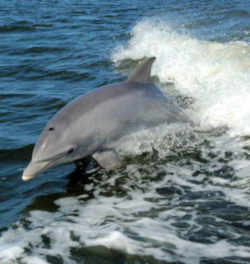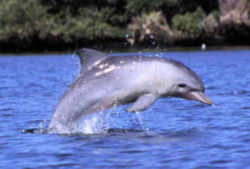
Florida Symbols
Florida State Saltwater Mammal
Porpoise

(Tursiops truncates)
Adopted in 1975
Is it a porpoise, or is it a dolphin? Even the 1975 Florida legislature, adopting the creature as the official saltwater mammal, left the issue open, designating the "porpoise, also commonly known as the dolphin," (Tursiops truncates.)
The terms porpoise and dolphin are often used interchangeably. Usually, they refer to the bottle-nose dolphin (Tursiops truncates), the species commonly found along Florida's Atlantic and Gulf coasts. Dolphins are gray with a lighter underside. They can live to the age of thirty, occasionally attaining a length of twelve feet, although most are in the six- to eight-foot range.
Dolphins use a system of echolocation, much like sonar, to determine their orientation. They have no sense of smell. Their keen eyesight, remarkable hearing, and wide variety of sounds (barks, clicks, and whistles) make dolphins especially interesting to study
Florida State Saltwater Mammal: Porpoise

Bottlenose dolphins, the genus Tursiops, are the most common and well-known members of the family Delphinidae, the family of oceanic dolphin. Recent molecular studies show the genus contains two species, the common bottlenose dolphin (Tursiops truncatus) and the Indo-Pacific bottlenose dolphin (Tursiops aduncus), instead of one. Research in 2011 revealed a third species, the Burrunan dolphin (Tursiops australis). Bottlenose dolphins inhabit warm and temperate seas worldwide.
The terms porpoise and dolphin are often used interchangeably. Usually, they refer to the bottle-nose dolphin (Tursiops truncates), the species commonly found along Florida's Atlantic and Gulf coasts. Dolphins are gray with a lighter underside. They can live to the age of thirty, occasionally attaining a length of twelve feet, although most are in the six- to eight-foot range.
Dolphins use a system of echolocation, much like sonar, to determine their orientation. They have no sense of smell. Their keen eyesight, remarkable hearing, and wide variety of sounds (barks, clicks, and whistles) make dolphins especially interesting to study.
Characteristics of the Porpoise
Size: Adults average 8-10 ft.(2.5-3 m). Males may be slightly larger than females.
Weight: Adults weigh between 300-650 lb. (136-295 kg).
Diet: These active predators eat a wide variety of fish, squid, and crustaceans.
Physical Description: Bottlenosed dolphins have a fusiform body that lacks many external characteristics of terrestrial mammals, including hair, external ears and hind limbs. A fusiform body reduces turbulence and allows bottlenosed dolphins to cruise underwater at high speeds. Dolphins have front flippers, a dorsal fin and flukes, which are used in swimming. The dorsal fin is tall, curved and set near the middle of the back. These dolphins are typically black to a light gray on their sides, and their bellies are white, sometimes with a slight pink hue. Bottlenosed dolphins are typically 84 to 140 cm at birth, and typically weigh between 14 and 20 kg. Adult males are usually between 244 and 381 cm long, and weigh about 500 kg. Adult females are typically between 228 and 366 cm, and weigh about 250 kg. This sexual dimorphism may be a result of females using energy to achieve sexual maturity at a earlier age than males, while males continue to grow.
Habitat: Bottlenosed dolphins are found everywhere except polar waters. Deep water bottlenosed dolphins come up to take breaths every 1 to 2 minutes, whereas inshore bottlenosed dolphins take breaths two times per minute. Bottlenosed dolphins have been known, however, to dive deep enough to go 4.5 minutes without taking a breath. Bottlenosed dolphins are found in bays, estuaries, sounds, open shorelines and large, estuarine rivers.
Fun Facts: Dolphins are extremely social animals and communicate through squeaks, grunts, moans and trilling sounds. They also send messages through body language by leaping, breaching (leaping out of the water and landing on their side) and smacking their tails against the water.
Florida Law
The law designating the porpoise, also commonly known as the dolphin as the official Florida state saltwater mammal is found in The Florida Statutes, Title 4, Chapter 15, Section 15.038.
CHAPTER 15
SECRETARY OF STATE
15.038 State marine mammal and state saltwater mammal.-
(1) The manatee, also commonly known as the sea cow, is hereby designated the Florida state marine mammal.
(2) The porpoise, also commonly known as the dolphin, is hereby designated as the Florida state saltwater mammal.
History.- s. 1, ch. 75-75.
Taxonomic Hierarchy: Porpoise
Kingdom: Animalia
Phylum: Chordata
Class: Mammalia
Order: Cetacea
Family: Delphinidae
Genus: Tursiops
Species: T. truncatus
Subspecies: T.t.truncatus
Subspecies: T.t.poncticus







